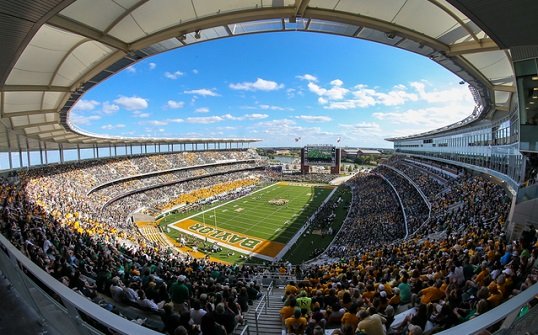The average size of a college football stadium varies significantly depending on the division and school, but here’s a Division I (FBS) The largest stadiums are found in the Football Bowl Subdivision (FBS), with an average seating capacity around 50,000 to 60,000. Major programs often have stadiums that exceed 80,000 seats. For example, Michigan Stadium, the largest in the U.S., holds over 107,000 fans.Division I (FCS) Football Championship Subdivision (FCS) stadiums are generally smaller, averaging around 20,000 to 25,000 seats, though some may hold more.
Division II and III These divisions have even smaller stadiums, typically ranging from 5,000 to 15,000 seats. They cater to smaller schools with less emphasis on large-scale spectator sports.Overall Average Considering all divisions, the overall average size of a college football stadium is approximately 30,000 to 40,000 seats.
This range reflects the diversity in college football programs and their respective fan bases, with larger schools boasting extensive facilities to accommodate their substantial followings.
What’s The Average Size Of A College Football Stadium?
The average size of a college football stadium varies by division. In Division I (FBS), stadiums typically seat around 50,000 to 60,000, with top programs exceeding 80,000. Division I (FCS) stadiums usually hold 20,000 to 25,000 seats, while Division II and III stadiums generally accommodate 5,000 to 15,000. Overall, the average size across all divisions is approximately 30,000 to 40,000 seats.
Historical Evolution
The historical evolution of college football stadium sizes reflects the sport’s growing popularity and commercial success,Early Years: Stadiums initially were small, accommodating a few thousand fans.Mid-20th Century: Rapid expansion occurred, with many schools building larger stadiums to meet increasing demand. Modern Era: Today, Division I (FBS) stadiums often exceed 50,000 seats, with some surpassing 100,000. Lower divisions have smaller, yet substantial stadiums, ranging from 5,000 to 25,000 seats. This evolution showcases the increasing scale and commercialization of college football over the decades.
Modern Developments
Modern developments in college football stadiums focus on enhancing the fan experience and incorporating advanced technology:
- Luxury Amenities: Many stadiums now feature luxury suites, club seating, and premium concessions.
- Technology: High-definition video boards, Wi-Fi access, and improved sound systems are common.
- Sustainability: Eco-friendly designs and practices, such as solar panels and water recycling systems, are increasingly prioritized.
- Multipurpose Use: Some stadiums are designed for various events, including concerts and other sports, to maximize usage.
These developments aim to attract fans, increase revenue, and improve sustainability.
Comparison by Conference
Here’s a summary comparing college football stadium sizes by conference:
- SEC (Southeastern Conference):
Average Size: Approximately 80,000 seats.
Largest Stadium: Kyle Field (Texas A&M) – 102,733 seats. - Big Ten:
Average Size: Around 75,000 seats.
Largest Stadium: Michigan Stadium (University of Michigan) – 107,601 seats. - Big 12:
Average Size: About 60,000 seats.
Largest Stadium: Darrell K Royal–Texas Memorial Stadium (University of Texas) – 100,119 seats.
ACC (Atlantic Coast Conference):
Average Size: Roughly 60,000 seats.
Largest Stadium: Doak Campbell Stadium (Florida State) – 79,560 seats.
- Pac-12:
Average Size: Approximately 55,000 seats.
Largest Stadium: Los Angeles Memorial Coliseum (USC) – 77,500 seats.
AAC (American Athletic Conference):
Average Size: Around 40,000 seats.
Largest Stadium: TDECU Stadium (Houston) – 40,000 seats.
- Mountain West:
Average Size: About 35,000 seats.
Largest Stadium: Qualcomm Stadium (San Diego State) – 71,294 seats.
Top 5 Iconic Stadiums
These averages illustrate the variations in stadium sizes across different conferences, reflecting the varying levels of investment and fan support in college football programs.
Here’s a summary of the top 5 iconic college football stadiums:
- Michigan Stadium (University of Michigan):
Nickname: “The Big House”
Capacity: 107,601 seats
Features: Known for its vast size and enthusiastic crowd, it is the largest stadium in the United States. - Rose Bowl (UCLA):
Capacity: 88,565 seats
Features: Historic venue in Pasadena, California, famous for hosting the annual Rose Bowl Game and numerous significant events, including Super Bowls and World Cup matches. - Notre Dame Stadium (University of Notre Dame):
Capacity: 77,622 seats
Features: Known for its rich tradition and “Touchdown Jesus” mural visible from inside the stadium, it is a symbol of college football history. - Tiger Stadium (LSU):
Nickname: “Death Valley”
Capacity: 102,321 seats
Features: Renowned for its intimidating atmosphere and passionate fans, especially during night games. - Ohio Stadium (Ohio State University):
Nickname: “The Horseshoe”
Capacity: 102,780 seats
Features: Iconic horseshoe-shaped design, known for its energetic crowd and tradition-rich environment.
These stadiums are celebrated for their historical significance, unique features, and the passionate fan bases they attract.
Historic Attendance Records:
Here are some historic attendance records from iconic college football stadiums:
- Michigan Stadium (University of Michigan, “The Big House”):
Record Attendance: 115,109 (September 7, 2013, vs. Notre Dame) - Ohio Stadium (Ohio State University, “The Horseshoe”):
Record Attendance: 110,045 (November 26, 2016, vs. Michigan) - Tiger Stadium (LSU, “Death Valley”):
Record Attendance: 102,321 (October 10, 2009, vs. Florida) - Rose Bowl (UCLA):
Record Attendance: 106,869 (January 1, 2014, Rose Bowl Game) - Darrell K Royal–Texas Memorial Stadium (University of Texas):
Record Attendance: 103,507 (September 4, 2016, vs. Notre Dame)
These records highlight the immense popularity and capacity of these stadiums during significant games and events in college football history.
Impact of Stadium Size:
The impact of stadium size in college football is multifaceted and influences various aspects of the game and fan experience:
- Fan Attendance and Atmosphere: Larger stadiums can accommodate more fans, creating a vibrant atmosphere with heightened crowd noise and enthusiasm, which can energize players and affect game dynamics.
- Revenue Generation: Stadium size correlates directly with ticket sales and revenue from concessions, merchandise, and premium seating options like luxury suites, influencing the financial stability and growth of college athletic programs.
- Recruitment and Prestige: Top-tier programs with large stadiums often attract high-caliber recruits drawn to the prestige and visibility associated with playing in front of large crowds and on national television.
- Community Engagement: Stadiums serve as community landmarks and gathering places, fostering local pride and providing a venue for community events beyond football games.
- Logistics and Operations: Managing larger stadiums requires significant logistical planning for crowd control, security, parking, and facilities management, impacting game-day operations and fan satisfaction.
- Event Hosting and Impact: Large stadiums enable universities to host major events, including college football playoff games, bowl games, concerts, and other non-sporting events, contributing to the local economy and cultural life.
In summary, stadium size plays a crucial role in shaping the competitive, financial, and cultural landscape of college football, influencing everything from fan engagement to revenue generation and community involvement.





